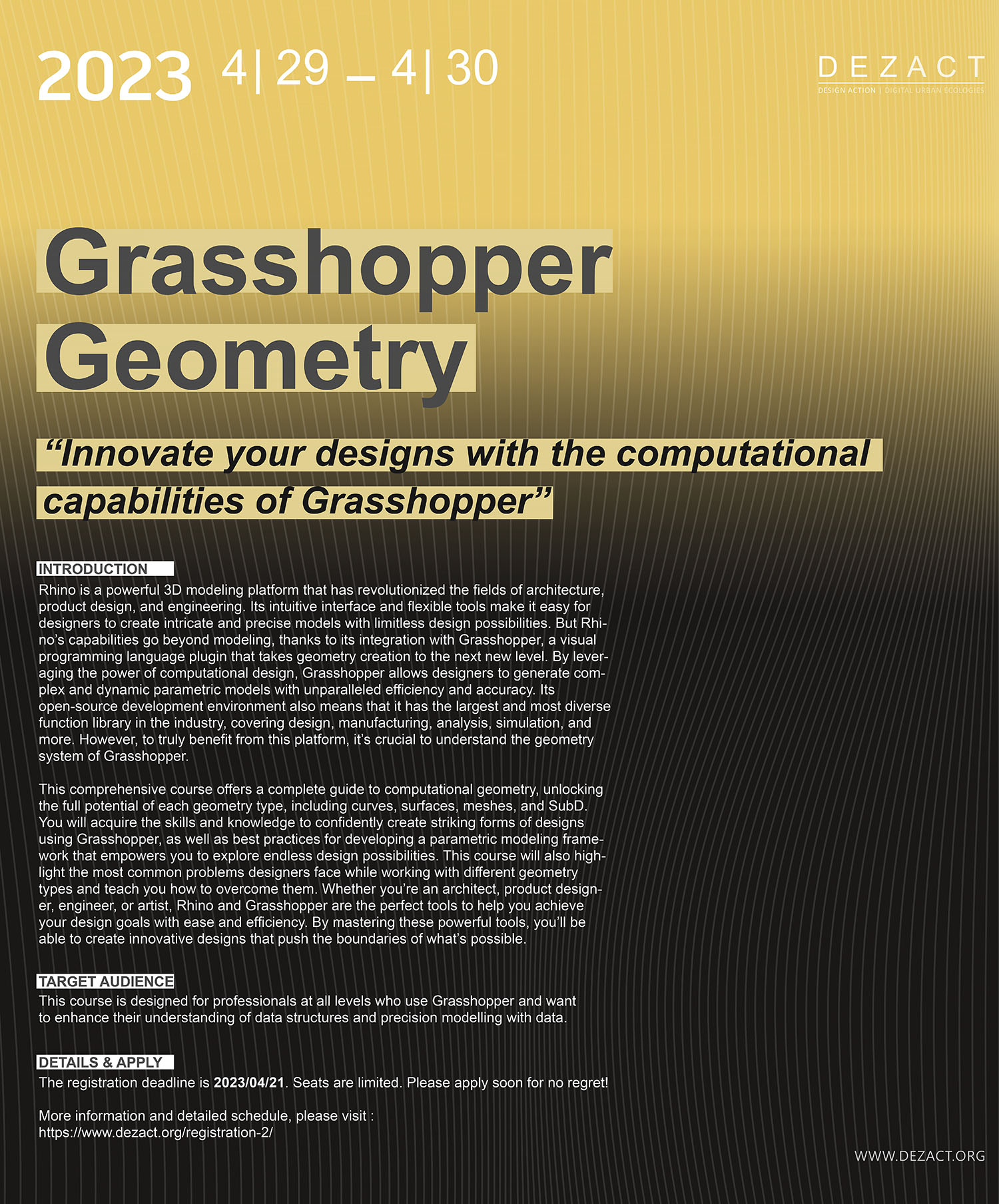
Date : 2023/04/29-04/30 (Sat/Sun) weekend
Time : 9:00-16:00 GMT
Course Format : online Zoom
Language : English
Target : This course is designed for professionals who are new to the software and are looking to improve their modelling workflow using Grasshopper. This course is open to individuals from various professional backgrounds, including but not limited to architecture, product design, jewelry design, engineering, fabrication, and art.
Software: Rhino 7.0 / Grasshopper /
Other Courses>>
Welcome to our Grasshopper Geometry course!
Course Introduction
Rhino is a powerful 3D modeling platform that has revolutionized the fields of architecture, product design, and engineering. Its intuitive interface and flexible tools make it easy for designers to create intricate and precise models with limitless design possibilities. But Rhino’s capabilities go beyond modeling, thanks to its integration with Grasshopper, a visual programming language plugin that takes geometry creation to the next new level. By leveraging the power of computational design, Grasshopper allows designers to generate complex and dynamic parametric models with unparalleled efficiency and accuracy. Its open-source development environment also means that it has the largest and most diverse function library in the industry, covering design, manufacturing, analysis, simulation, and more. However, to truly benefit from this platform, it’s crucial to understand the geometry system of Grasshopper.
This comprehensive course offers a complete guide to computational geometry, unlocking the full potential of each geometry type, including curves, surfaces, meshes, and SubD. You will acquire the skills and knowledge to confidently create striking forms of designs using Grasshopper, as well as best practices for developing a parametric modeling framework that empowers you to explore endless design possibilities.
This course will also highlight the most common problems designers face while working with different geometry types and teach you how to overcome them. Whether you’re an architect, product designer, engineer, or artist, Rhino and Grasshopper are the perfect tools to help you achieve your design goals with ease and efficiency. By mastering these powerful tools, you’ll be able to create innovative designs that push the boundaries of what’s possible.
Have you ever encountered the following situations?
One of the most common challenges designers face is managing the large amount of input parameters and selecting the right geometry type for each situation. This course can help you overcome these obstacles by providing you with the knowledge and skills to work confidently with different types of geometry.
Join us to explore the answers to these common questions:
A. What are the differences between NURBS, Mesh, and SubD, and what are their unique properties?
B. How can I convert between NURBS geometry and mesh/SubD geometry while maintaining accuracy and continuity?
C. How do I trim and split NURBS curves and surfaces in Grasshopper?
D. How can I work with imported NURBS geometry that has issues with edge continuity or surface intersections?
E. How do I choose between different NURBS creation tools, and are there any differences between them?
F. What is the difference between rational and freeform curves?
G. How can I control the orientation of the NURBS surface or mesh normals?
H. How can I simplify complex mesh geometry without losing important details?
I. How can I control the density of mesh topology to optimize for performance and rendering quality?
J. How can I optimize my Grasshopper scripts for faster processing and avoid slow performance when dealing with large geometries?
K. How can I troubleshoot common errors and crashes when working with NURBS, mesh, and SubD geometries in Grasshopper?
Expectation of the course
If you’re new to computational geometry, multi-object modeling, and data flow control, transitioning from Rhino to Grasshopper can be challenging to master. That’s why we’ve designed a two-day course led by our experienced trainer, Ping-Hsiang Chen, to guide you through a comprehensive curriculum covering all aspects of computational geometries in Grasshopper. During the course, you’ll benefit from hands-on exercises and practical examples that will help you apply what you’ve learned to real-world design scenarios. You’ll also have access to our trainer, who will answer your questions and provide personalized support throughout the course.
Upon completing the course, you will have the skills and knowledge to effectively select and utilize the appropriate geometry functions in different contexts. With this expertise, you will be able to maintain better control over your parametric models, resulting in more efficient and sophisticated designs.
Instructor Intro
Ping-Hsiang Chen is a highly skilled computational design expert with more than 10 years of experience. He is a UK registered architect and chartered member of RIBA, currently working as a Senior Architect at Zaha Hadid Architects. Previously, he held key positions at Applied Research Team in KPF and Mamou-Mani Architects, where he was responsible for providing geometric and architectural solutions. In addition, he is the founder of GrasshopperCourse.com, a leading consultancy that offers comprehensive software development and training services to top companies in various design disciplines including McNeel Europe.
04/29 – Morning
a. Computational Geometry
b. Rhino Geometries
c. Numerical Control
d. Parametric Modelling Framework
04/29 – Afternoon
a. Data Matching
b. Vectors and Planes
c. Curve Properties and Parameters
d. Transformation Methods
04/30 – Morning
a. Surface Domain
b. Proximity Based Modelling
c. Geometry Mapping
d. Data Visualisation
04/30 – Afternoon
a. Mesh Modelling Introduction
b. Mesh Subdivision and Optimization
c. Introduction to Sub D
d. Geometry Interoperability
